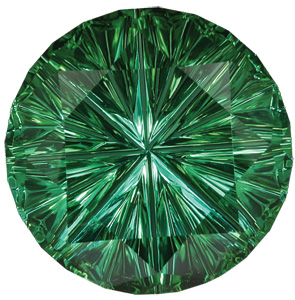|
Colored Gemstone
Shades of Green
Tourmaline in all hues and green gemstones were top sellers for colored gem dealers at the AGTA GemFair.
By Nancy Pier Sindt

|
| 14.56-carat green tourmaline StarbriteTM cut by John Dyer & Co. Photograph by Lydia Dyer. |
Green gemstones, including emerald, tourmaline, peridot and jade, were getting the most attention at the recent American Gem Trade Association (AGTA) GemFair in Las Vegas. The reasons? Partly to satisfy the fashion choice of American designers –– emerald green is the Pantone Color of 2013 — and partly to entice cash-rich Chinese buyers, who prefer green and pink tourmaline to most other gemstones.
James Alger of his self-named company in Bedford, New Hampshire, said, “Green is in, especially green tourmaline and peridot.” However, these stones don’t come cheap. Alger estimated prices for the most in-demand gems, such as blue-green tourmaline, tanzanite and unheated sapphire, have risen close to 20 percent over the past year. Geoffrey Watt, principal at Mayer & Watt, Maysville, Kentucky, cited green tourmaline and rubellite as top sellers. Also getting attention was one of this company’s more unusual gems — a trapiche from Muzo, Colombia, which is a natural formation of six emerald crystals fused into a star, or cogwheel, shape. The stones are sliced and polished to be used in rings or pendants.
The trend for gemstone slices continues, and exhibitors showed all manner of flat, polished free-form cuts from rubies, sapphires and emeralds to tourmaline and smoky and rutillated quartz. Chunky, rough-cut beads also were popular in beryl, amethyst, colored quartz and tourmaline. Bead specialist Robert Bentley of his eponymous company in New York City, said his sales, as always at this show, reflected an eclectic mix, but the top-sellers were strands of rare Mozambique tourmalines in green and blue tones. The appeal of moonstone continues and buyers sought a range of colors in beads and cabochons, including the rare rainbow moonstone, as well as blue sheen, soft greens, caramels and honey-toned moonstones from India, Sri Lanka and Tanzania. Moonstone specialist Barbara Lawrence of Brookline, Massachusetts, who deals directly with designers and private collectors, noted that there are greater quantities of moonstones coming on the market right now. Many of these gems are from private collections so they are of higher quality and rarity — and command higher prices. For example, the rare rainbow moonstone can fetch up to $500 per carat.
Baroque pearls were also a strong look, often in sizes as large as 23 mm. While the great majority of the biggest ones were Chinese freshwater pearls, dealers also showed South Sea white and golden pearls, as well as Tahitians. One of the most exciting new looks came from Sea Hunt Pearls, San Francisco, with its so-called “fireballs,” ultra-large baroque freshwater pearls in a rainbow of blended natural colors. Some of these exceptionally lustrous pearls exhibited peach, lavender, pink and purple tones in a single pearl. According to a company spokeswoman, this rainbow coloration is due to a new hybridizing process of the pearl-producing mussels. Top-quality strands wholesale for about $800 per strand.
The market for untreated rubies and sapphires was strong, as was demand for the rarer colors of familiar stones such as padparadscha sapphire, tourmaline and rainbow moonstone. At A. Hakimi & Sons, New York City, buyers were seeking larger, finer-quality untreated rubies from Burma and Mozambique. Asians, in particular, were the most enthusiastic ruby buyers, especially in the rare pigeon’s blood color. High-quality emeralds and sapphires from 2 carats to 10 carats were leading categories for Sparkles & Colors USA, New York City, said Sailesh Lakhi, who noted that there were also many requests for yellow sapphires, particularly larger stones. “People are looking for unusual, exotic gemstones as well as gems that are exceptional and therefore less available,” observed Omi Nagpal, president of Omi Gems Inc., Los Angeles. Of course, prices of the rarities are rising steadily. Nagpal estimated that rubies and sapphires have gone up 15 percent over 2012. In addition to these gems, Omi featured a new collection of padparadscha sapphires in soft, peachy pink tones. Also requested during this show were tourmaline and color-change gems such as alexandrite. Gabriel Mattice, Pala International, Fallbrook, California, said, “At this show, buyers were looking for mostly rarities and unusual sizes. Most popular gemstones included rubies, sapphires, red spinel and demantoid garnet.” This latter gem is part of the “cuprian,” or copper-bearing family, which includes tourmaline of all hues, strong sellers because of their color and fiery brilliance. Andrew S. Rosenblatt, designer at Akiva Gil Co., New York City, supplier of loose gems and finished jewelry, said, “Overall, the most in-demand gemstones were tourmaline of all colors, sapphire, emerald, aquamarine and rubellite.” Also attracting attention was recently discovered Ethiopian opal that is very fiery but less expensive than Australian opals. Pearl dealers ASBA USA, Sarasota, Florida, introduced a new collection of one-of-a-kind colored gemstone rings with diamond accents. “We are selling as many as we can make,” reported Chief Executive Officer (CEO) Cyril Israileff. The new collection, he said, wholesaling from $500 to $2,500, “is not haute couture, but fashion ready-to-wear.” Among the best-selling gems in the collection were pink tourmalines, spessartite garnets and large, baroque South Sea pearls. Showcasing a large collection of one-of-a-kind carved gemstones was John Dyer & Co., Edina, Minnesota. David Dyer, the designer’s father, who is a partner in the business, said most of the firm’s customers are bench jewelers or designers. Best-sellers for his company at this show were pink and green tourmalines, which were being purchased by both American and Chinese buyers. Overall, this year’s GemFair exhibitors said they see that their buyers — domestic and foreign designers, retailers and manufacturers — are restocking, which they interpret as a positive move. As Alger noted, “Most retailers are understocked in gemstones and gems are a time-tested store of value.”
Article from the Rapaport Magazine - July 2013. To subscribe click here.
|
|